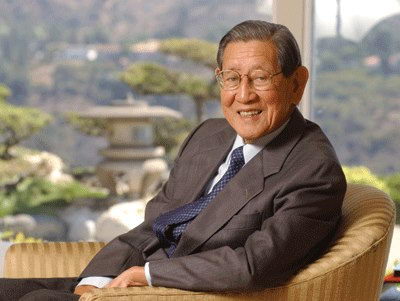Born in Gardena (Los Angeles area) on May 22nd, 1917 George was the only child of Setsuo and Yoshiko Aratani, Japanese immigrants and farmers.
George’s parents were determined to become successful, and despite the racially restrictive land laws and practices in California at that time, they moved to Guadalupe, CA about 170 miles north of Los Angeles and Setsuo built an agricultural empire.
He accumulated 5,000 acres planted in vegetables, a hog farm, a chemical and fertilizer factory and a global trading company.
Life was going so well, that as a young man George’s parents sent him to Japan to live with his grandmother to learn the Japanese language and culture, and to enroll at Tokyo’s prestigious Keio University.
But while George was in Japan, his mother died and his father’s health began to fail, so George returned to California, at first enrolling at Stanford University in 1940, and then when his father died, dropping out of school to run the family businesses.
That is until December 7th, 1941 when Japan bombed Pearl Harbor, triggering the U.S. entrance into World War ll and setting off a wave of anti-Japanese hysteria in America.
From that hysteria, on February 19th, 1942 President Roosevelt signed Executive Order 9066 rounding up 120,000 Japanese Americans and nationals: men, women and children, all viewed as potential spies, and incarcerating them in “camps” for the duration of the war.
They were given just days to sell their homes, cars, businesses and other possessions, forced to sell at fire sale prices before reporting to the camps.
A company George’s dad did business with agreed to oversee the Aratani business empire, but during the war nearly all of those businesses were lost.
In George’s personal life, before the war, he was introduced to young and pretty Sakaye Inouye and during the time they were both incarcerated at two different Arizona camps, they still got to know each other.
Because George spoke English and Japanese, in 1944 the U.S. Army sent him to a Minnesota army base to teach Japanese to U.S. soldiers. Just before he left, he married Sakaye and took her with him to Minnesota.
When the war ended in 1945, George was broke and the anti-Japanese racial bias continued, as did the restrictive real estate laws and practices. But he and Sakaye relocated to the Los Angeles area to make a new life for themselves and to raise their family (they would have two daughters, Linda and Donna).
Because the U.S. dollar was strong and the Japanese economy was devastated by war, George saw an opportunity that could help everyone. In 1946, he formed what would become American Commercial, Inc. and tried importing and exporting various kinds of goods.
His first big success came in 1951 with AMCO, an exporter of U.S.-made medical and scientific equipment, whose top quality products made them in demand the world over.
In 1957, George added a second business Mikasa, to import inexpensive Japanese tableware at a time when U.S. households were growing and prosperous. In 2000, when he sold that firm, it had $400 million in annual sales.
In 1961, he got involved in a third business, with a Japanese maker of car stereo equipment and renamed the company Kenwood to give it a name appealing to Americans. This was when the car culture in America had really taken off and Kenwood became a huge success.

George Aratani
George went on to become a very wealthy man. But to him, this wealth was largely meaningless if he didn’t use it to help others. Over the years, he became one of America’s biggest Japanese-American philanthropists, funding numerous charitable and educational programs.
But on February 19, 2013, 95 year old George passed away from complications from pneumonia, at Santa Monica-UCLA Medical Center. His survivors included Sakaye, his wife of 68 years and their daughters, Linda and Donna.
But the impact of his charity work continues, as George’s intent was to make life a little nicer for all of us, with his products and with his financial generosity.
